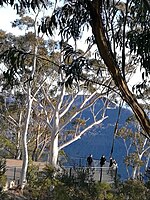Lilianfels, Katoomba

Lilianfels is a heritage-listed former villa and holiday house and now luxury hotel located at 10-16 Panorama Drive, Katoomba in the City of Blue Mountains local government area of New South Wales, Australia. The house was designed by Varney Parkes and was built in 1889 by Sir Frederick Darley, Chief Justice of NSW, as his mountain retreat. The property is privately owned. It was added to the New South Wales State Heritage Register on 2 April 1999.The house was named Lilianfels in honour of Darley's daughter who had recently died. Lilian was her name and fels is German for high ground. The Darleys owned the house for twenty years and then sold it. The property is now part of a resort and spa which provides accommodation, restaurant facilities and caters for special events, particularly weddings.
Excerpt from the Wikipedia article Lilianfels, Katoomba (License: CC BY-SA 3.0, Authors, Images).Lilianfels, Katoomba
Panorama Drive, Sydney
Geographical coordinates (GPS) Address Nearby Places Show on map
Geographical coordinates (GPS)
| Latitude | Longitude |
|---|---|
| N -33.7294 ° | E 150.3104 ° |
Address
Panorama Drive
2780 Sydney
New South Wales, Australia
Open on Google Maps









